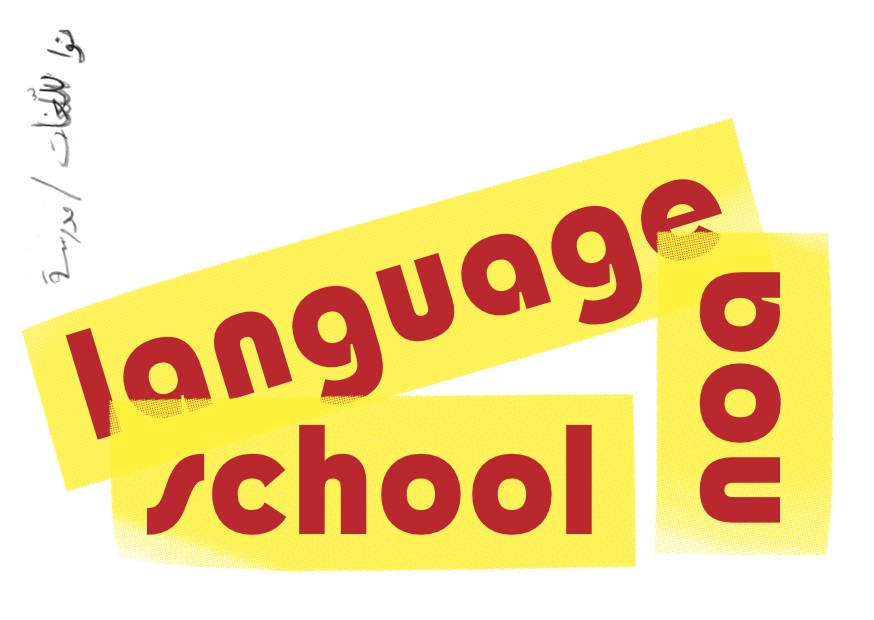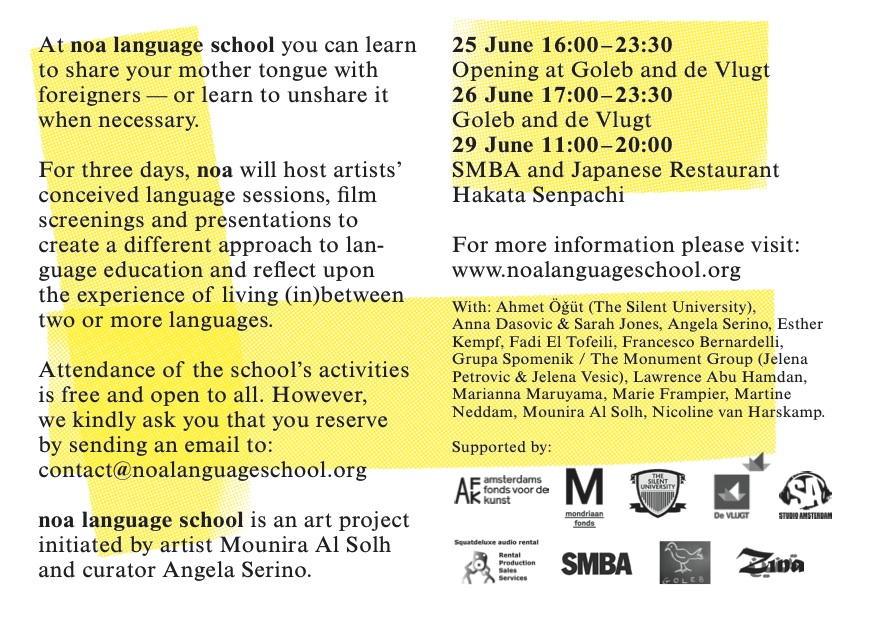Dates: 25-26-29 June 2013
Places: Stedelijk Museum Bureau Amsterdam, Goleb, Zina, Studio Amsterdam and the Japanese Restauant Hakata Senpachi.
noalanguageschool is a project developed by curator Angela Serino and artist Mounira Al Solh and supported by a research grant from the Mondriaan Fund.
Artists and participants: Mounira Al Solh, Martine Neddam, Fadi El Tofeili, Lawrence Abu Hamdan, Francesco Bernardelli, Marianna Maruyama, Grupa Spomenik/The Monument Group (Jelena Petrović and Jelena Vesić), Ahmet Öğüt, Marie Frampier, Esther Kempf, Anna Dasovic and Sarah Jones, Nicoline van Harskamp.
Credits image: Presentation at SMBA, with Angela Serino and Nicoline van Harskamp.
noa language school is attempting to create a different approach to language education, starting from the experience of living (in)between two or more languages.
noa language school is led by artists who invite the public to learn or unlearn existing or artificial languages, as a means of exploring and creating other selves and an alternative sense of community. At noa language school you can learn to share your mother tongue with foreigners—or learn to unshare it when necessary. noa allows you to explore the use and comprehension of languages from different sides and positions. Throughout the various sessions that make up this three-day school, artists will stage expert talks to train the ear of Dutch people listening to the broken Dutch spoken by immigrants; a writer and an artist invite us to intimately learn Arabic words by describing the sounds with the help of an Italian opera singer; and Moroccan ladies will physically train us, moving our jaws to help us repeat the words they use to describe Dutch people.
noa language school Amsterdam was made possible by the financial support of Amsterdams Fonds voor de Kunst, SMBA, Squat Deluxe.
Here below you can read some of the comments of the participants to our activities.
“It had the sense of being something in progress and that really appealed to me, possibly because it made me feel more involved, that we were all shaping the way things went. I also thought this approach, as well as shared meals, film screenings, and a sense of play (playing with language, playing with the voice) made the whole thing relaxed and prompted conversations that began with what we had been doing (what workshops, the ways in which they were odd or a bit surreal / how they made us feel) leading to what they made us think about.” (Sarah Forrest, artist from Glasgow)
“It took me a week to sink in the experience and realize that I learned a few important things, most important probably the idea of expertise. Everybody is an expert in this field of languages and it’s a very democratic subject to bring people together.” (Nicoline van Harskamp, artist from Amsterdam)
“I was very insecure, thinking what can I teach to those artists? But the round table worked very well, they all listened to what I said with a lot of interest, and I enjoyed their stories of moving in or out in different countries. The conversation took a philosophical turn at the second half of our talk…” Kenneth Chin Sue (works as a transportation car driver in Amsterdam).
“Each of the language sessions created in its own way a collectively produced space where different tongues, hands, personalities and nationalities confronted each other, and did not pretend that there were no borders between them. This helped a more organic bridging between all those languages.” (A.M.)


Public discussion at SMBA
"How to Lose Your Voice: Exercises to Achieve the Loss of Voice", language session Marianna Maruyama, Goleb
"Hafif …" language session by Fadi El Tofeili and Mounira Al Solh, studio Salve (Niek de Wit )
"Learning Language by Eating", language session Marianna Maruyama, Japanese Restaurant Hakata Senpachi
"Tell me a story you don’t know", Anna Dasovic and Sarah Jones, performance, SMBA. Photo credit: Melanja Palitta, Igor Sevcuk.






